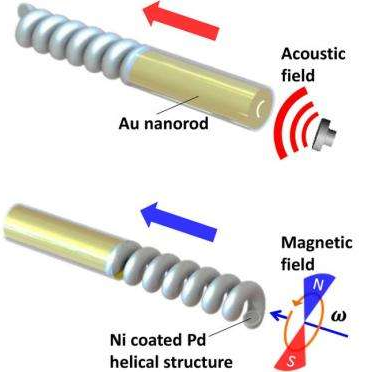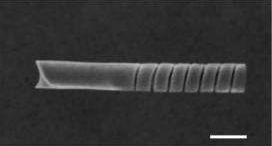A team of researchers has published a paper detailing a nanomotor that is powered by magnetic and acoustic fields, making it the first ever magneto-acoustic hybrid, fuel-free nanomotor.

Nanoscale motors can be built to run all sorts of chemical fuels, including hydrogen peroxide and others. They can also be built to run without fuel, instead being powered by either magnetic or acoustic fields. Professor Joseph Wang, who teaches at the University of California (San Diego), led the team that successfully created a nanomotor with a bisegmented design — it includes a gold nanorod segment that responds to ultrasound, and a nanohelical magnetic segment that responds to magnetic fields.
It’s a unique strategy made all the more impressive by the fact that it measures approximately 3000nm long.

Per the team, by using different fields to power a single nanomotor, they’re able to offer a technology that can quickly reconfigure the larger device’s operation. For example, due to the fact that the fields act on opposite ends of the device, switching between both ends rapidly changes the direction of motion. Also, tuning the amplitude of the ultrasound waves or the frequency of the magnetic field allows for rapid speed regulation, and applying a rotational magnetic field induces a torque that results in a corkscrew motion.
Also worth pointing out is that by using fields instead of fuel gives the nanomotor the advantage of being able to work in highly ionic environments like seawater and blood. This is something that was not previously available, as these types of environments interfere with the propulsion mechanisms of chemically powered nanomotors that often rely on the electric-field-induced motion of electrophoresis.
One particularly interesting discovery the group made during their trial sessions is that when several of the new nanomotors are placed closely together, they exhibit a sort-of swarming behavior. Furthermore, the team observed three different states of switchable collective behavior, which was dependent upon the applied field: stable aggregation with just ultrasound, directional swarm with magnetic, and a swirling vortex when both fields were applied.
Looking ahead, technologies outfitted with magnetic and acoustic actuation capabilities could lead to significantly smarter technologies. For instance, smart nanovehicles that autonomously reconfigure themselves in order to change in the environment or their performance for the purpose of achieving a predetermined mission. This could be especially useful for biomedical applications like imaging, drug delivery, and diagnosis. Beyond that, it could also be used for nanoscale manipulation and assembly in the field of artificial nanomachines.
Read the team’s full study, entitled Magneto-Acoustic Hybrid Nanomter
Via Phys.org
Advertisement
Learn more about Electronic Products Magazine





